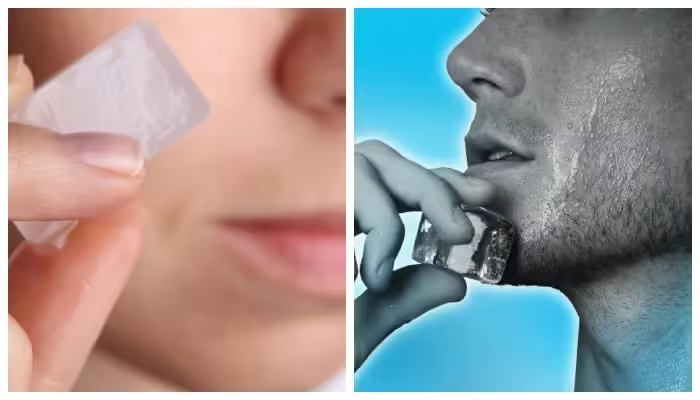Using ice on the face is a popular beauty technique that has been gaining attention for its potential benefits. This practice is not new; it is rooted in ancient Chinese skincare methods known as “ice therapy.” The idea is simple: applying ice to the skin can stimulate blood circulation, reduce inflammation, and enhance overall skin appearance. However, while there are numerous benefits, there are also potential downsides to this practice if not done correctly. Let’s explore both the advantages and the disadvantages of using ice on your face.
Benefits of Applying Ice to Your Face
Natural Skin Tightening:
One of the most notable benefits of applying ice to the face is its ability to tighten the skin. The cold temperature causes the blood vessels to constrict, which temporarily reduces the appearance of pores and creates a smoother, more youthful look. This tightening effect can also help to reduce the appearance of fine lines and wrinkles.
Reduction of Puffiness and Swelling:
Ice therapy is highly effective in reducing facial puffiness, particularly around the eyes. The cold constricts blood vessels, which can diminish swelling and puffiness caused by factors like lack of sleep or allergies. This is why many people find it beneficial to apply ice to their face first thing in the morning to achieve a more refreshed appearance.
Improvement in Blood Circulation:
Applying ice to the face can stimulate blood flow, which is essential for maintaining healthy skin. Improved circulation delivers more oxygen and nutrients to the skin cells, promoting a healthy glow and aiding in the repair of damaged skin.
Enhanced Makeup Application:
Many makeup artists and beauty enthusiasts swear by the practice of applying ice before makeup. The cold temperature can help to create a smoother canvas by reducing the appearance of pores and preventing the skin from producing excess oil. This can be particularly beneficial in hot weather, where makeup might otherwise melt or slide off due to excess sweat and oil.
Soothing Effect:
Ice can also be soothing on irritated skin. It can help to reduce redness and calm inflamed areas, making it an excellent remedy for those suffering from conditions like acne or rosacea. The cooling effect can also alleviate pain and discomfort associated with these skin issues.
Hydration and Freshness:
Regularly applying ice to the face can help to maintain skin hydration, especially for those who suffer from dry skin. Ice can lock in moisture and give the skin a fresh, dewy appearance. This makes it a simple yet effective remedy for dryness, particularly when moisturizers alone are not enough.
Risks and Disadvantages of Applying Ice to Your Face
Risk of Skin Damage:
While ice can offer numerous benefits, it can also be harmful if not used properly. Applying ice directly to the skin can cause frostbite or burns, particularly in those with sensitive skin. This can result in redness, irritation, or even permanent damage if the ice is left on for too long.
Exacerbation of Skin Conditions:
Individuals with certain skin conditions, such as rosacea, should be cautious when using ice. The extreme cold can cause flare-ups or worsen symptoms, as it might trigger the blood vessels to expand once the skin warms up again, leading to increased redness and irritation.
Temporary Numbness:
Holding ice against the skin for too long can cause temporary numbness or a tingling sensation. While this might seem harmless, it indicates that the skin is being exposed to too much cold, which could lead to damage if the practice is continued.
Ineffectiveness for Severe Skin Issues:
While ice can reduce minor puffiness or redness, it is not a cure-all for more severe skin issues. Relying solely on ice therapy for significant skin problems may delay appropriate medical treatment and exacerbate the condition.
Over-Drying the Skin:
Although ice can help to lock in moisture, it can also cause the skin to dry out if used excessively. This is because the cold temperature can constrict the natural oils in the skin, leading to an overly dry and tight feeling.
Precautions and Best Practices
If you decide to incorporate ice therapy into your skincare routine, it is essential to do so safely:
- Wrap the Ice: Always wrap ice cubes in a clean cloth or towel before applying them to your skin. This will prevent direct contact and reduce the risk of frostbite or burns.
- Limit Exposure Time: Avoid holding the ice on one spot for too long. Move the ice in circular motions and limit each session to no more than 10-15 minutes.
- Avoid Sensitive Areas: Be cautious when applying ice around sensitive areas, such as under the eyes or on the lips. These areas are more prone to irritation and damage.
- Listen to Your Skin: Pay attention to how your skin reacts. If you notice increased redness, irritation, or discomfort, discontinue the practice and consult with a dermatologist if necessary.
Applying ice to the face can be a quick and effective way to enhance your skin’s appearance, offering benefits such as reduced puffiness, tightened pores, and a refreshed look. However, it is crucial to approach this practice with caution to avoid potential skin damage. By following the recommended precautions, you can safely enjoy the benefits of ice therapy as part of your skincare routine.



